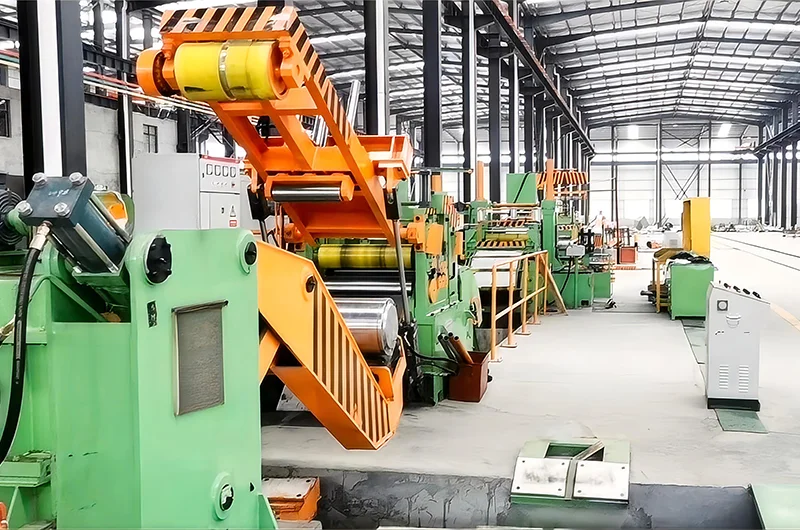How to Train Employees to Operate Slitter Rewinders for Metal Coils
Jul 18,2025

How to Train Employees to Operate Slitter Rewinders for Metal Coils
Table of Contents
- 1. Introduction to Slitter Rewinders
- 2. Importance of Proper Training for Slitter Rewinders
- 3. Understanding Slitter Rewinder Components
- 4. Developing a Comprehensive Training Program
- 4.1. Identifying Training Objectives
- 4.2. Assessing Employee Skill Levels
- 4.3. Creating Training Materials
- 5. Hands-On Training Techniques
- 5.1. Safety Protocols and Guidelines
- 5.2. Step-by-Step Machine Operation
- 5.3. Troubleshooting Common Issues
- 6. Evaluation and Feedback Mechanisms
- 7. Continuous Improvement in Training
- 8. Conclusion
- 9. Frequently Asked Questions (FAQs)
1. Introduction to Slitter Rewinders
Slitter rewinders are critical machines in the metal processing industry, designed to convert large rolls of metal coils into smaller, manageable rolls. These machines cut the metal into specified widths and rewind the material for further processing. Training employees to operate slitter rewinders effectively is essential for maintaining production efficiency and ensuring safety in the workplace.
2. Importance of Proper Training for Slitter Rewinders
Training employees to operate slitter rewinders is not just about understanding how to use the equipment. Proper training ensures that employees can identify potential hazards, adhere to safety protocols, and perform their tasks efficiently. A well-trained workforce contributes to increased productivity, reduced downtime, and lower operational costs.
3. Understanding Slitter Rewinder Components
Before diving into the training process, it’s crucial to familiarize employees with the components of slitter rewinders. Here are the key parts:
3.1. Blades
Blades are vital for cutting the metal coils to the desired width. They must be sharp and properly maintained to ensure clean cuts.
3.2. Unwind Station
The unwind station holds the large metal coils before they are fed into the machine for slitting.
3.3. Rewind Station
The rewind station collects the slitted metal, allowing operators to manage the output effectively.
3.4. Control Panel
The control panel is where operators input settings and monitor the machine's performance.
Understanding these components will help employees grasp how the slitter rewinder operates and the importance of each part in the overall process.
4. Developing a Comprehensive Training Program
Creating an effective training program involves several steps, from defining training objectives to assessing employee skill levels.
4.1. Identifying Training Objectives
To develop a robust training program, we must first identify the specific objectives. Goals may include:
- Understanding machine operation and safety protocols.
- Learning to conduct routine maintenance and troubleshooting.
- Mastering quality control measures to ensure product specifications.
4.2. Assessing Employee Skill Levels
Assessing the skill levels of your employees is crucial. Conducting a skills assessment can help identify training needs and tailor the program to meet the diverse requirements of your workforce.
4.3. Creating Training Materials
Effective training materials should include clear instructions, visuals, and hands-on guides. Consider using:
- Video demonstrations of machine operation.
- Detailed manuals outlining safety protocols and maintenance procedures.
- Checklists for daily operational tasks.
5. Hands-On Training Techniques
Hands-on training is essential for employees to develop real-world skills in operating slitter rewinders. Here are some techniques to implement:
5.1. Safety Protocols and Guidelines
Before operating any machinery, employees must be well-versed in safety protocols. Training should cover:
- Personal protective equipment (PPE) requirements.
- Emergency shutdown procedures.
- Safe handling of metal coils and materials.
5.2. Step-by-Step Machine Operation
Conduct training sessions that guide employees through the machine's operation step-by-step. This should include:
- Loading the metal coil onto the unwind station.
- Adjusting settings on the control panel.
- Monitoring the cutting process and ensuring quality.
5.3. Troubleshooting Common Issues
Employees should be trained to identify and address common issues that may arise during operation, such as:
- Blade dullness and replacement.
- Misalignment of coils.
- Operational inconsistencies.
6. Evaluation and Feedback Mechanisms
To ensure the effectiveness of the training program, implementing evaluation and feedback mechanisms is crucial. Consider the following strategies:
6.1. Regular Assessments
Conduct regular assessments to gauge employee understanding and skill proficiency. Assessments can be in the form of written tests or practical demonstrations.
6.2. Employee Feedback
Solicit feedback from employees regarding the training program. Understanding their perspectives can help refine and improve future training sessions.
7. Continuous Improvement in Training
Training should not be a one-time event. Establish a continuous improvement plan that includes:
- Ongoing training sessions to address new technologies or methods.
- Refresher courses to reinforce skills and knowledge.
- Updates to training materials based on industry advancements.
8. Conclusion
Training employees to operate slitter rewinders for metal coils is a critical investment in your workforce and production capabilities. By developing a comprehensive training program, emphasizing hands-on techniques, and establishing continuous improvement practices, your organization can enhance efficiency, safety, and overall productivity within the metal processing industry.
9. Frequently Asked Questions (FAQs)
1. What is a slitter rewinder?
A slitter rewinder is a machine used in the metal processing industry to cut large rolls of metal coils into smaller, specified widths for easier handling and further processing.
2. Why is employee training important for operating slitter rewinders?
Proper training minimizes the risk of accidents, enhances productivity, and ensures that employees can efficiently operate and maintain the equipment.
3. What safety protocols should be addressed during training?
Training should cover the use of personal protective equipment (PPE), emergency procedures, and safe handling techniques for metal coils.
4. How can we assess employee skill levels before training?
Conduct skills assessments through interviews, practical demonstrations, and observation of current operational practices.
5. What materials are essential for an effective training program?
Essential training materials include instructional manuals, video demonstrations, checklists, and hands-on guides that outline procedures and best practices.
By implementing a thorough training program, organizations can ensure that employees are equipped with the knowledge and skills necessary to operate slitter rewinders efficiently, leading to improved workplace safety and productivity.
PREVIOUS:
Articoli recenti






